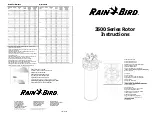
74
Ground Resistance Tester Model 6471
does not fall out, carefully lift off the back of the unit, turn it over and
place it next to the front panel with the electronic components.
7.
Press the clip off the plug, and pull out the plug with the four battery
leads (in the corner, near the terminal for the optical interface). Avoid
touching the circuitry or components.
8.
Remove the old battery from the case and put in a new one. Run the
leads with the plug through the largest slot in the battery case.
9.
Insert the battery plug (in the corner, near the terminal for the optical
interface). The two pins should point towards the clip. Avoid touching the
circuitry or components.
10.
Return the back of the unit (with the new battery in the case) to the front
panel with the components, taking care not to stretch the battery leads.
Carefully lower the back of the unit and make sure that it is aligned
correctly (the four cylindrical holes on the back must slip over the four
mounting pins on the front panel). Also make sure you do not pinch the
battery leads or other wires or components.
11.
Pull the battery a short way out of the case without overstretching the
connection leads, and retighten the two screws at the bottom of the
case. Then put the battery back into the case.
12.
Put the lid back onto the battery case and screw it shut.
13.
Wipe off any dirt on the seal and housing rim.
14.
Put the unit back into the housing and screw it into place.
15.
Fully charge the new battery in the unit before using it.
16.
Reset the time and date.
NOTE:
If the instrument is not used for long periods of time (more than 6
months), it is recommended, in order to recover the initial capacity of the
battery, to make several charge-discharge cycles (3 to 5 times). Discharge
cycle (15 H) can be made with the instrument in
MANUAL
mode, DC 2-Pole
(2-Pole) resistance measurement and a short-circuit between
H (Z)
and
E (X)
plugs.
www.
ShopAEMC
.com
Shop for AEMC products online at:
1.888.610.7664













































